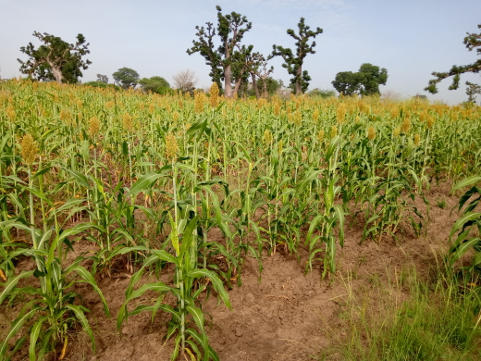Article /
CLIMAP portal: online climate tool to support Senegalese agricultural planning

This article was originally posted on Future Climate for Africa on 28 April 2020. It was written by Leonie Joubert as part of a series covering the science produced by various FCFA projects, and introducing some of the people behind it.
Introduction
Agriculturalists in government, the private sector, and development organisations in Senegal have an appetite for climate information to assist with planning, in order to make the sector more resilient in the face of anticipated climatic changes. But they often find this information too technical and inaccessible, or too general to be useful for local-level planning.
The CLIMAP portal, developed through the AMMA 2050 project and the French Convention for climate services, is an online climate information tool has been designed to bridge this gap. Training in how to use the tool is set for technical advisors in this important Senegalese agricultural producing country later in 2020.
This article describes why and how the CLIMAP portal was developed, and how it works. Supporting documentation, including surveys and an assessment of user needs, are also provided below.
Methodology – developing CLIMAP
The first step in developing CLIMAP was to understand users’ needs. To do this, a survey was conducted to seek input from relevant stakeholders, including those in West Africa, which then informed the content and design of the portal. It aimed to better understand the needs of users and provide guidelines for effectively communicating climate and climate-impact information in the region. The results of the survey are presented and discussed in Sultan et al., 2020: “Current needs for climate services in West Africa: Results from two stakeholder surveys”. This study compares the survey results to another surveys in West Africa conducted within the ISIpedia project, and explores some differences that might be due to the methodology or to real differences between respondants.
After gaining this udnerstanding of user needs, the team started to develop the tool with frequent interactions with the Met Service of Senegal (ANACIM) who are very close to end-users. Once the team had a prototype version of CLIMAP set up, several demos, tests and trainings with users in Senegal and also at COP24 and COP25 were used to improve the portal.
Lessons Learnt while developing CLIMAP
The surveys used to capture user’s climate information needs demonstrated that climate and climate-impact information is very relevant to West African respondents’ activities. This information is already being used for a diverse range of activities among the respondents, mostly to help develop adaptation plans but less to inform operational activities or decision-making (e.g. providing subsidies or fertilizers to farmers, dimensioning of engineering structures, internal planning of portfolio deployment for an insurance company or bank).
The overall results strongly support the need for an effective engagement between the providers and the users of climate servicesin order to address many issues with current climate services in West Africa highlighted by the surveys. The stakeholder engagement process should go beyond the collection of user input for the design of climate services and incorporate capacity-building of both users and providers of climate services.
Barriers inhibiting existing climate services
The surveys also highlighted a number of barriers prevent existing climate services from fully fulfilling the role they could play. The respondents identified the irrelevance or the incompleteness of the information these services provide,which is mostly related to the lack of high-resolution information or high uncertainties, as the most important obstacle. The lack of training to understand the provided information was also raised by the respondents as an important barrier, which calls for capacity-building activities to ensure the effective uptake of information offered by climate services.
CLIMAP Portal
TheCLIMAP portalallows users to customise climate and agriculture projections for Senegal by setting parameters for crop type, temperature, and rainfall in the online tool. The user then applies one of three climate scenarios, according to a timeframe of their choosing between now and 2100. These climate scenario options are framed as ‘optimistic’ (one that assumes a lowering of carbon emissions, which slows future global heating), a medium emissions scenario, and a ‘worst case’ scenario, which assumes emission rates continue on their current trajectory.
The online tool then generates map and graph outputs which show the user what the likely climatic conditions will be for a region’s crops, or what the crop yields might be in the specific year the user requested.Initial data is sourced from theCoupled Model Intercomparison Project Phase 5 (CMIP5) global climate models andbias-corrected for Africa using CDF-t method as part of theAMMA 2050 project, then re-scaled by month. Crop yield results have been obtained bySARRA-H Ocelet. All this data comes as raster data with resolution 0.5°x0.5°, which was cut and weighted to match country and administrative regions.
The tool is geared towards technical advisors and similarly skilled staff within Senegalese sub-national government or administrative bodies, as well as civil society, private companies, international organisations and environmental consultancies. The information the site generates is intended to assist with regional adaptation planning, outreach, lobbying, strategic and operational planning, and research.
‘The portal was developed to help decision-makers integrate climate information into agricultural development planning,’ explains Dr Youssouph Sane from the Agence Nationale de l’Aviation Civile et de la Météorologie (ANACIM) in Dakar, Senegal.Sane is also part of AMMA-2050, a collaboration of climate researchers who helped develop the online tool together with various partners inSenegal, France, and the United Kingdom.
‘We designed it to provide technical information to decision-makers so they can better integrate climate change into local development planning.’
TheFrench Institute of Research for Development (IRD) led the portal development, and funding came from the theFrench Ministry for an Ecological and Solidary Transition as part of the Convention on financial support for climate services.
Next steps
Portal development: The CLIMAP portal is constantly being improved. Currently (Q4, 2020), the team are working on it to add new data (CMIP6 simulations, hydrological simulations) and to have a version hosted by ANACIM in Senegal.Trainings are underway with IT persons in ANACIM.
Training:AMMA-2050 had a roadshow scheduled across five regions in Senegal for the first half of 2020, with train-the-trainer workshops aimed at national and sub-state technical advisers and researchers on how to use the climate information portal.
‘The objective of the training is to share the portal with officials working at national and sub-national levels, and across various government departments, as well as key research institutions, so that they can use this tool to integrate climate information into their agricultural planning,’ explains Emma Visman, a senior knowledge exchange officer at UK Centre for Ecology and Hydrology, the institution coordinating for this Future Climate For Africa-funded project.
However, the training has to be rescheduled in response to the restrictions on movements during the COVID-19 pandemic. Movement between regions within Senegal is currently restricted, while key partners from France, who would be instrumental in running the training, are also not currently able to travel to Senegal.
Since the tool is online, some training may be able to be done remotely, according to Visman, but face-to-face workshops would be more effective. Some departments may also have insufficient internet access to allow for online training.
AMMA-2050 has an extension to continue its work in Senegal until March 2021 and may be able to reschedule the training to be done after the Senegalese rainy season, from June to October, which is when many of the national meteorological agency staff and agriculture technical experts are tied up with operational matters.
For now, training resources can be found here:
- Un démonstrateur de Services Climatiques au Sénégal (video presentation)
Expanding the CLIMAP portal
The current portal team also have plans to apply for further funding to develop a regional version of CLIMAP that will include more countries. If you are interested in this work please contact Benjamin SULTAN (benjamin.sultan@ird.fr) and Youssouph SANE (youssouph@gmail.com).
Related resources
- Using climate information to support adaptation planning and policy-making: Step-by-step guide
- Increase your knowledge on Climate & Resilience through the CARE Academy
- Ensuring climate information guides long-term development
- AMMA 2050: African Monsoon Multidisciplinary Analysis 2050
- IMPALA: Improving Model Processes For African Climate
